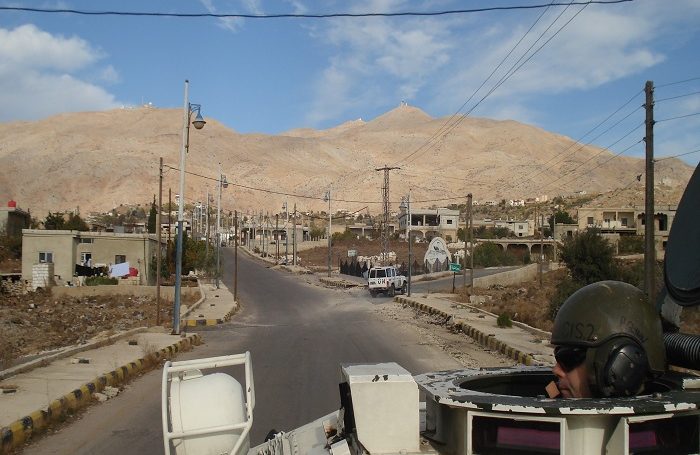
Russian President Vladimir Putin recently announced a ‘significant’ troop withdrawal from the Syrian campaign on an unannounced visit to the Hmeimim airbase, near Latakia. Having made a similar promise to withdraw troop numbers last year, will Putin follow through this time round? As with most of Putin’s policies, he keeps his cards very close to his chest. However, a brief analysis here will conclude that this is the most likely outcome.
It’s been only a few short weeks since Putin announced that he will run for re-election in spring 2018; in an event which is all but assured, the real contest there is who will move as kingmaker to replace a constitutionally barred Putin for running again in 2024. Despite this, being able to tell the Russian people that he is bringing home Russian troops after what, by most accounts, has proven to be a highly positive military intervention, will prove key to electoral success and domestic opinion ratings.
A second factor in determining the decision for partial withdrawal is the enormous success with which the Russian military has largely achieved its aims. After two years of air strikes and a ground combat campaign, Russia proved pivotal in reclaiming lost regime territory from both Islamic State (IS) and, more indiscriminately, rebel factions and civilians. The London based Syrian Observatory for Human Rights have put the civilian death toll in Syria caused by Russian strikes at 6,328, including 1,537 children. Russia denies causing any civilian casualties, but an observer with even a basic understanding of Russian tactics will believe that to be highly unlikely.
However, without Russian military intervention, the battle for Aleppo and the highly destructive stalemate would likely have degraded further, having only been reclaimed last year by a Russian push. The cities of Hama and Homs are now also under government control, as well as the ancient city of Palmyra, all with Russian military support. Most recently, Deir ez-Zor has been cleared of IS, along with key oil fields previously under the caliphate’s control. This represents an increase of four times the territory the regime controls, compared to before the Russian military intervention in 2015.
In numerical terms, the Russian military has conducted 30,650 combat sorties in Syria, delivering 92,000 strikes against 96,800 targets. As of October 2017, by some reports as many as an estimated 53,000 IS and al-Nusra fighters have been killed. Again, the ambiguity of precisely who has been killed will long reign; but there is little denying the utility with which Russia has demonstrated in helping to eliminate IS and, in the eastern deserts especially, the capture of key ground and oil revenues away from the caliphate.
The costs to Russia have not been insignificant though. Financially, estimates have run at $4 million per day for the war effort; a running total of over the perceived current amount so far of $2.2 billion; a relatively high figure for a country unaccustomed to maintaining a high military tempo in over a generation. The Russian military too have suffered comparatively highly; 41 military deaths, including two generals, with a further 104 private military company deaths also being reported. Taken together this figure almost represents the 179 military deaths suffered by the UK in the Iraq War (2003 – 2009), so by no means an insignificant figure.
Though what Russia has gained from its Syrian intervention is insurmountable. In the immediate aftermath of the invasion of Ukraine and the annexation of Crimea in 2014, Russia was feeling especially vulnerable and increasingly referred to as a pariah state by the West. Its success in Syria though has secured it a seat at the negotiating table for Syria’s future; now looking increasingly certain to be defined by Russia, Iran and Turkey in the wake of a lack of American and European influence.
Russia has also managed to save its only truly Middle Eastern ally, President Assad, ensuring Russian presence in the Middle East for several generations to come. Assad has already agreed to the continued use of Russia’s military bases in Syria until at least 2050, crucially including its naval base at Tartus. This guarantees Russian maritime access to the Mediterranean; historically the preserve of European powers, most notably Great Britain, France and Italy.
Russia’s real prize however is the redrawing of the geopolitical power it now wields in the region. Despite varying reports of a lack of capability in Russian military equipment, the Syrian intervention has showcased to the world that actually Russia is again a military power to be reckoned with, capable of sustaining a military campaign far from its borders. As 2017 draws to a close, and with it a Russian troop withdrawal and renewed focus for peace in Syria into 2018, Putin will have secured himself his next election victory and, with it, the return of Russia to the world stage.
Further Reading on E-International Relations
- Opinion – Assad’s Regime Has Fallen: Time to Lift Sanctions on Syria
- Opinion – Germany’s Flawed Russia Policy Has Its Roots in a Misreading of History
- Opinion – Russia’s Choices in Ukraine
- Opinion – China and the Rebuilding of Syria
- Turkey’s Role in Syria: A Prototype of its Regional Policy in the Middle East
- Opinion – A Hidden Victory? The Winter War and Russia’s Invasion of Ukraine